“Should I use Shopify Markets or create separate expansion stores for my international business?”
If you’re asking this question, you’re not alone. Many Shopify merchants face this exact dilemma when expanding beyond their home country. The choice between these options significantly impacts your operations, costs, and customer experience.
You might be struggling with:
- Deciding whether to manage everything from a single store or set up separate stores
- Understanding the true costs of each approach beyond the subscription fees
- Figuring out how either option affects your team’s workload
- Determining which solution better serves your customers in different regions
In this article, you’ll explore the key differences between Shopify Markets and Expansion Stores and understand which option makes sense for your specific situation.
Let’s start by clearly defining what these options actually are, since many merchants confuse them.
Bonus: Explore Choosing Between Shopify and Shopify Plus!
Shopify Markets: Features, Benefits, Limitations, and Costs
As businesses look to expand globally, managing multiple international storefronts presents significant challenges. Shopify’s integrated solution addresses these pain points with a comprehensive approach.
What is Shopify Markets?
Shopify Markets is a built-in tool that lets you sell internationally from a single Shopify store. Introduced in 2021, it allows you to create multiple “markets” within one store, each customized for different countries or regions.
From a single Shopify admin, you can manage these markets while customizing the shopping experience for customers in different regions.
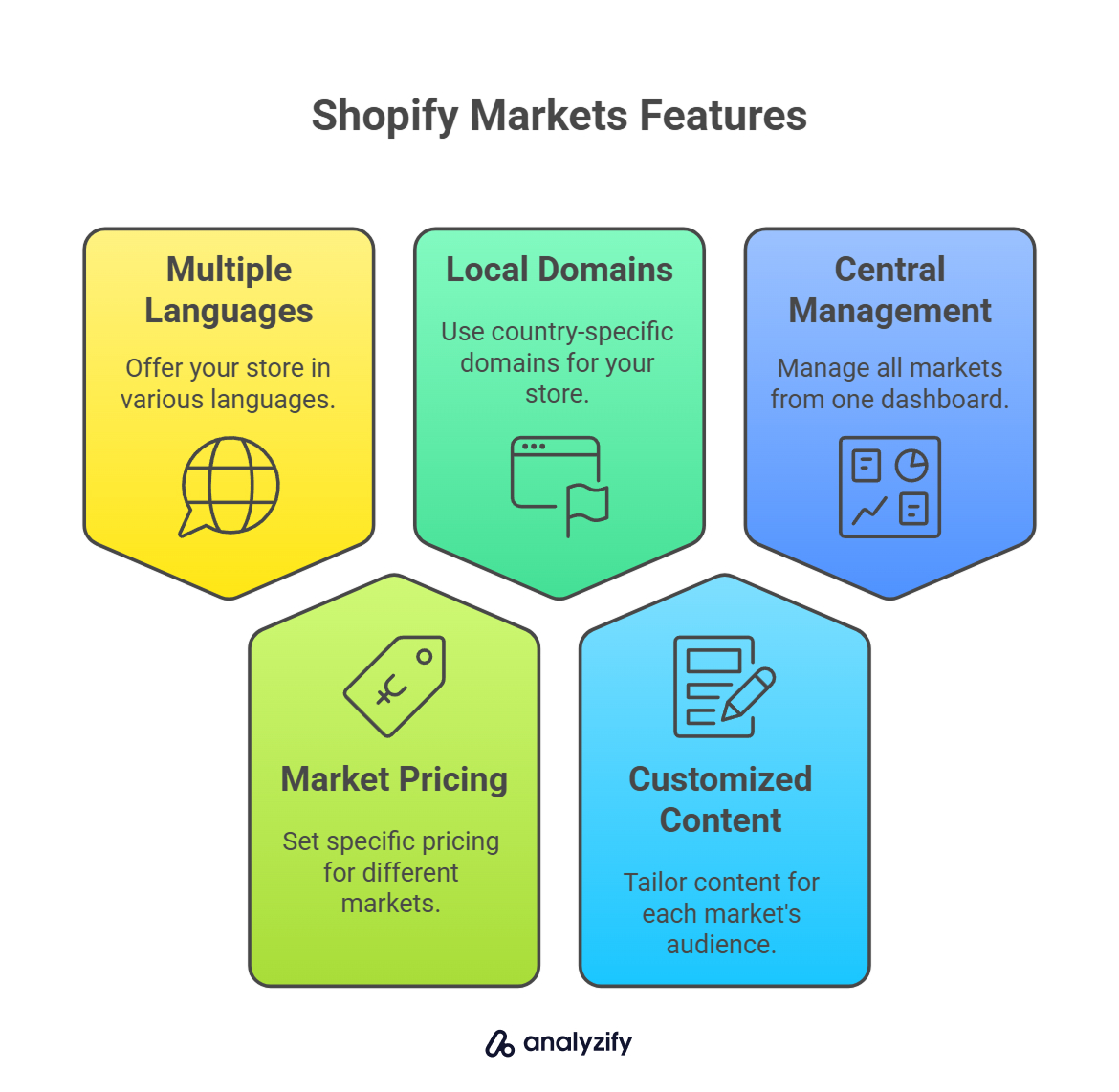
With Shopify Markets, you can:
- Offer your store in multiple languages and currencies
- Set market-specific pricing and product availability
- Use local domains for each market (like yourstore.fr for France)
- Customize content for each market
- Manage everything from a single Shopify admin dashboard
Key Features and Capabilities of Shopify Markets
Shopify Markets delivers a robust suite of internationalization tools that allow merchants to create tailored experiences for customers around the world. Let’s explore the seven core capabilities that power this global selling solution:
1. Market-specific Domains
With Shopify Markets, you can establish dedicated URLs for each market region. This includes options for country-specific domains (like yourstore.de for Germany) or subfolders (yourstore.com/de/).
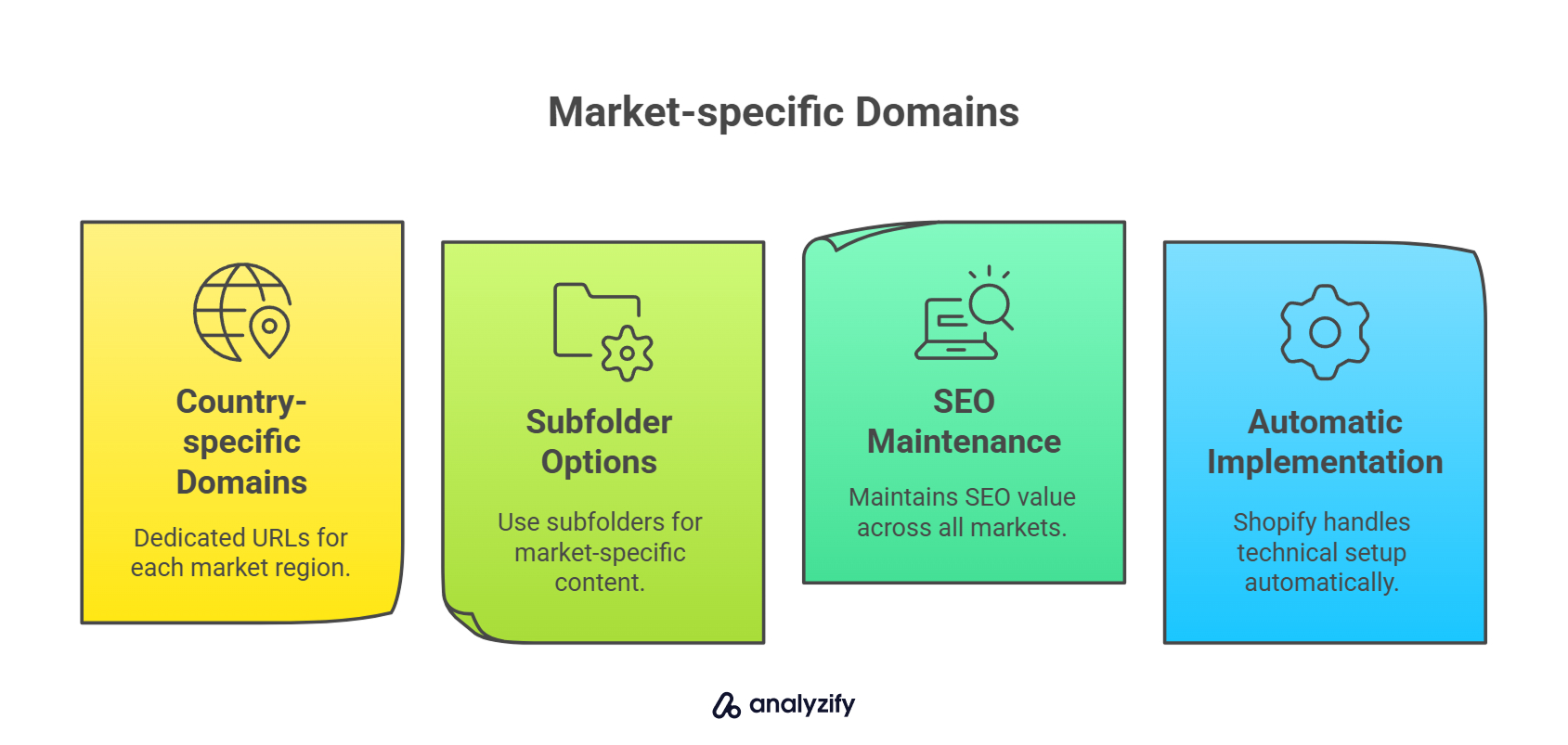
The system maintains SEO value across all markets, allowing you to build your international presence while leveraging your existing domain authority. The technical implementation happens automatically, with Shopify handling proper hreflang tags and SEO configuration.
2. Product Catalog Management
Shopify Markets gives merchants control over which products are available in each market. You can customize product offerings based on local preferences, regulations, or inventory restrictions by adjusting pricing and visibility settings for each market.
Important note: Shopify Markets does not support separate stock tracking per market. Additionally, products can only be hidden by removing their price in a specific market rather than through a direct visibility toggle.
3. Content Localization
With Shopify Markets, you can customize your storefront for each market by adjusting banners, product descriptions, promotional materials, and images based on your customers’ location and language.
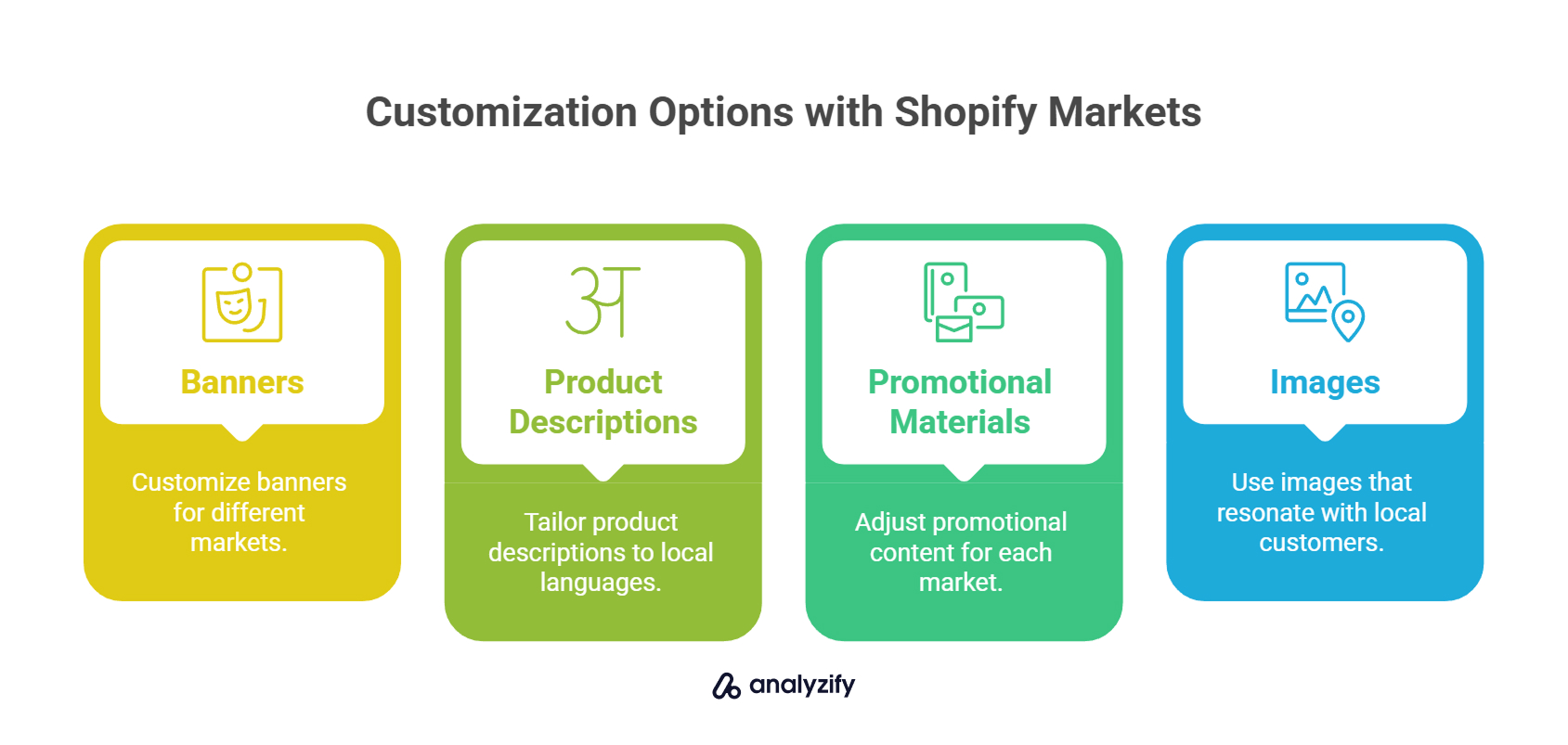
The Shopify theme customizer makes it easy for you to specify which content appears for different countries and languages. However, keep in mind that some elements, like collection structures and homepage layouts, apply globally, which might limit full customization.
If you need completely distinct storefronts for different regions, setting up expansion stores may be a better option.
4. Language Translation
Shopify Markets supports multilingual stores, allowing you to display your store in multiple languages. While it provides the technical framework for language switching, translations must be added manually using Shopify’s Translate & Adapt app or third-party tools.
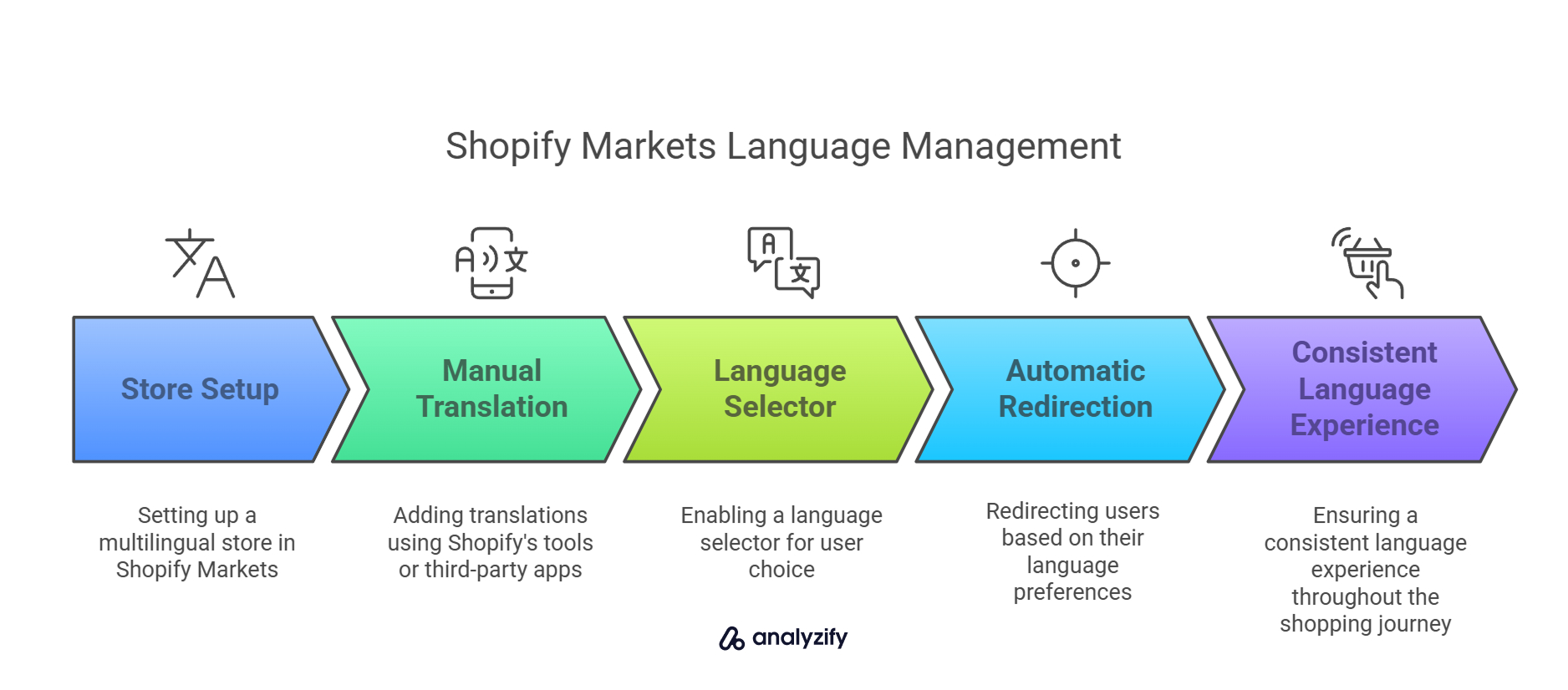
By default, Shopify did not automatically change a store’s language based on the visitor’s location.
However, with the introduction of the Language redirection feature on January 15, 2024, you can now enable automatic redirection based on the visitor’s browser language. To activate this feature, follow these steps:
Activate Automatic Redirection
- Log in to your Shopify admin panel.
- Go to Settings > Markets.
- Click on Preferences.
- In the Automatic redirection section, activate Country/region redirection.
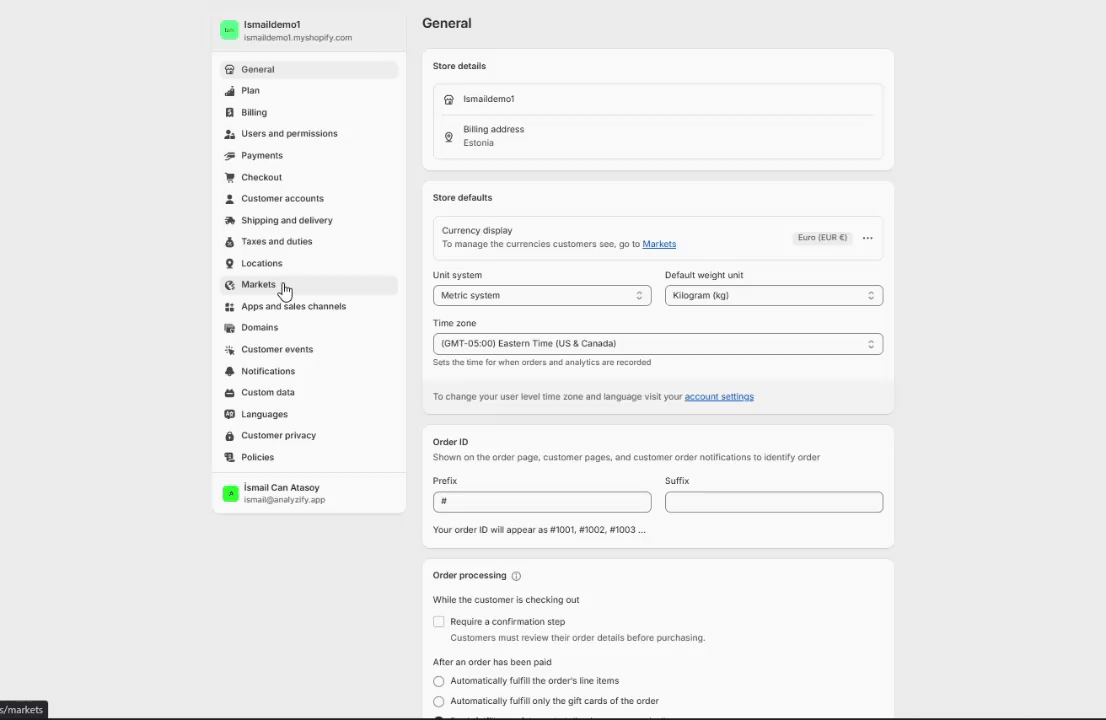
After activating country/region redirection, region-specific content is automatically displayed to customers in your online store.
You can also let customers manually switch between countries and languages by enabling selectors on your online store. If your theme doesn’t have a built-in country or language selector, you can add them using a third-party app from the Shopify App Store.
Note: Automatic redirection is based on the customer’s IP address, directing them to the appropriate regional store without the need for a pop-up.
For example, if your primary domain is shop.com for the U.S., and you’ve set up a Canadian market at shop.com/en-ca, customers from Canada will be automatically redirected to the /en-ca subfolder.
5. Currency Management
Shopify Markets enables pricing in local currencies, helping international customers shop in a familiar format. It offers two pricing options:
- Automatic currency conversion: Prices adjust based on real-time exchange rates when using Shopify Payments.
- Manual fixed pricing: You can set specific prices per currency, ensuring strategic control over international pricing.
Regarding payouts, Shopify Payments allows receiving funds in multiple currencies if your store is on the Advanced Shopify or Shopify Plus plan and is located in a supported region. This involves adding multiple bank accounts in the respective currencies.
Without meeting these criteria, payouts are made in your store’s default currency, and currency conversion fees may apply.
6. Tax and Duty Calculation
As of February 2, 2025, Shopify extended duties and import tax calculation to all plans.
Previously restricted to Advanced and Plus users, this feature now allows any merchant using Shopify Markets to show estimated taxes and duties at checkout based on the buyer’s location—reducing unexpected costs for customers.
 To use this feature, just turn on the duty calculator in your Shopify admin (Settings > Taxes and Duties) and make sure your products have the right Harmonized System (HS) codes and country/region of origin listed.
To use this feature, just turn on the duty calculator in your Shopify admin (Settings > Taxes and Duties) and make sure your products have the right Harmonized System (HS) codes and country/region of origin listed.
By showing all costs upfront, you help reduce cart abandonment caused by unexpected charges.
Note: But keep in mind—if you don’t activate this feature or use a third-party service like Zonos or Global-e, your customers might still have to pay duties upon delivery, depending on local tax rules.
7. Local Payment Methods
Shopify Markets supports payment options popular in specific regions, increasing conversion rates by meeting local customer expectations. For instance, customers in Germany might prefer direct bank transfers, while Dutch customers often use iDEAL.
The system automatically presents the most relevant payment options based on the customer’s location. To enable these local payment methods, merchants must use Shopify Payments as their primary payment provider.
Bonus: Discover ” Top Shopify Alternatives: Compare Pricing & Features”
Pricing and Fee Structure of Shopify Markets
Shopify Markets is included with all Shopify plans, but the capabilities and costs vary:
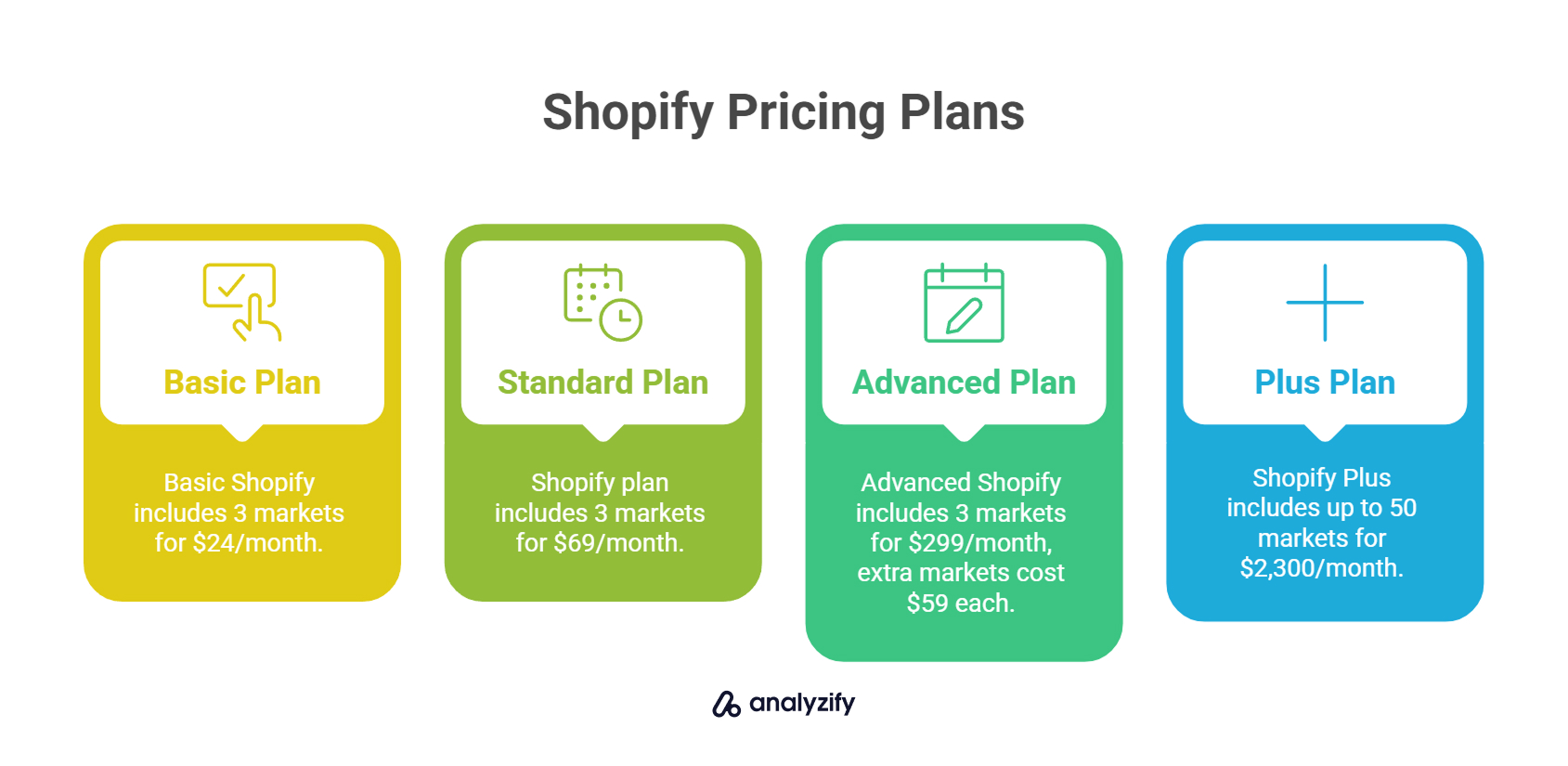
- Basic Shopify ($24/month): Includes 3 markets
- Shopify ($69/month): Includes 3 markets
- Advanced Shopify ($299/month): Includes 3 markets, with additional markets costing $59/month each
- Shopify Plus ($2,300/month): Includes up to 50 markets at no additional cost
Important: The subscription cost isn’t the only expense to consider. Shopify Markets charges a 2% fee on transactions made in currencies other than your store’s primary currency. This fee covers currency conversion services and is applied on top of regular Shopify payment processing fees.
For high-volume merchants, these transaction fees can add up quickly and might outweigh the benefits of a single-store approach.
Limitations to Consider
While Shopify Markets offers many advantages, there are several important limitations to be aware of before implementation:
Payment Processing
Shopify Markets requires using Shopify Payments as your payment processor. While this ensures smooth integration, it means you’re bound by Shopify Payments’ availability in different countries and its 7-day limit on capturing payments after an order is placed.
Content Management and Language Control
Managing content across multiple markets from a single store streamlines operations but comes with limitations:
- Only one person can edit the theme at a time, creating potential bottlenecks when multiple team members need to update content for different markets simultaneously.
- Making extensive differences between markets becomes increasingly complex within a single store setup, despite the customization options.
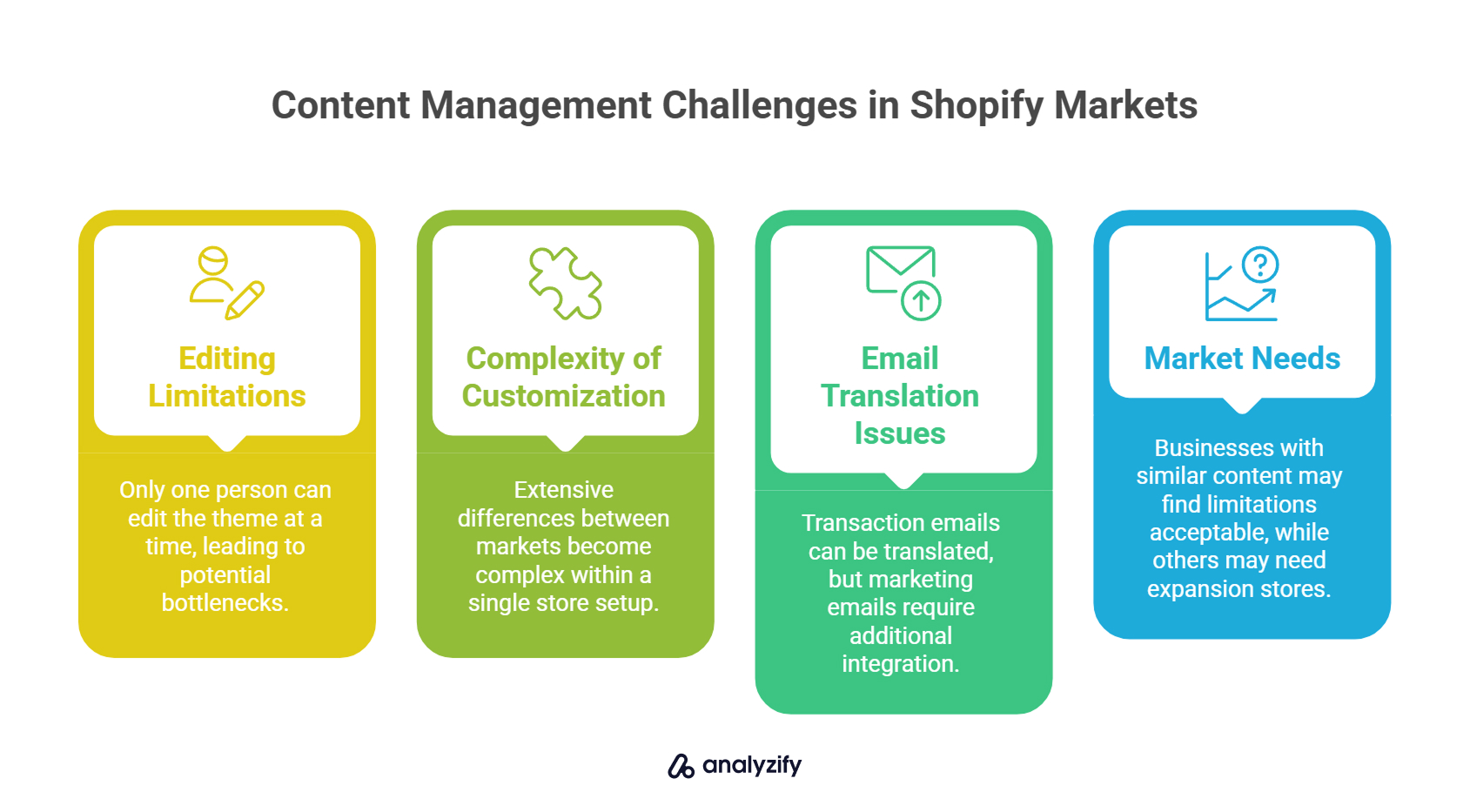
Email translations present specific challenges compared to website translations:
- Transaction emails can be translated through the Translate and Adapt app
- Marketing and other emails either require Klaviyo integration or will contain all languages at once
For businesses with similar content needs across markets, these limitations may be acceptable. However, if your markets require substantially different approaches or dedicated teams for each region, expansion stores might be more suitable.
Technical Compatibility
Before committing to Shopify Markets, verify compatibility with your current app stack. Not all third-party apps fully support Markets functionality, which could create operational issues if you rely heavily on specific apps.
Implementation Process
Implementing Shopify Markets is relatively straightforward:
- Enable Markets in your Shopify admin
- Create and configure each market with specific settings
- Set up domains or URL structures for each market
- Configure languages, currencies, and payment methods
- Customize content for each market as needed
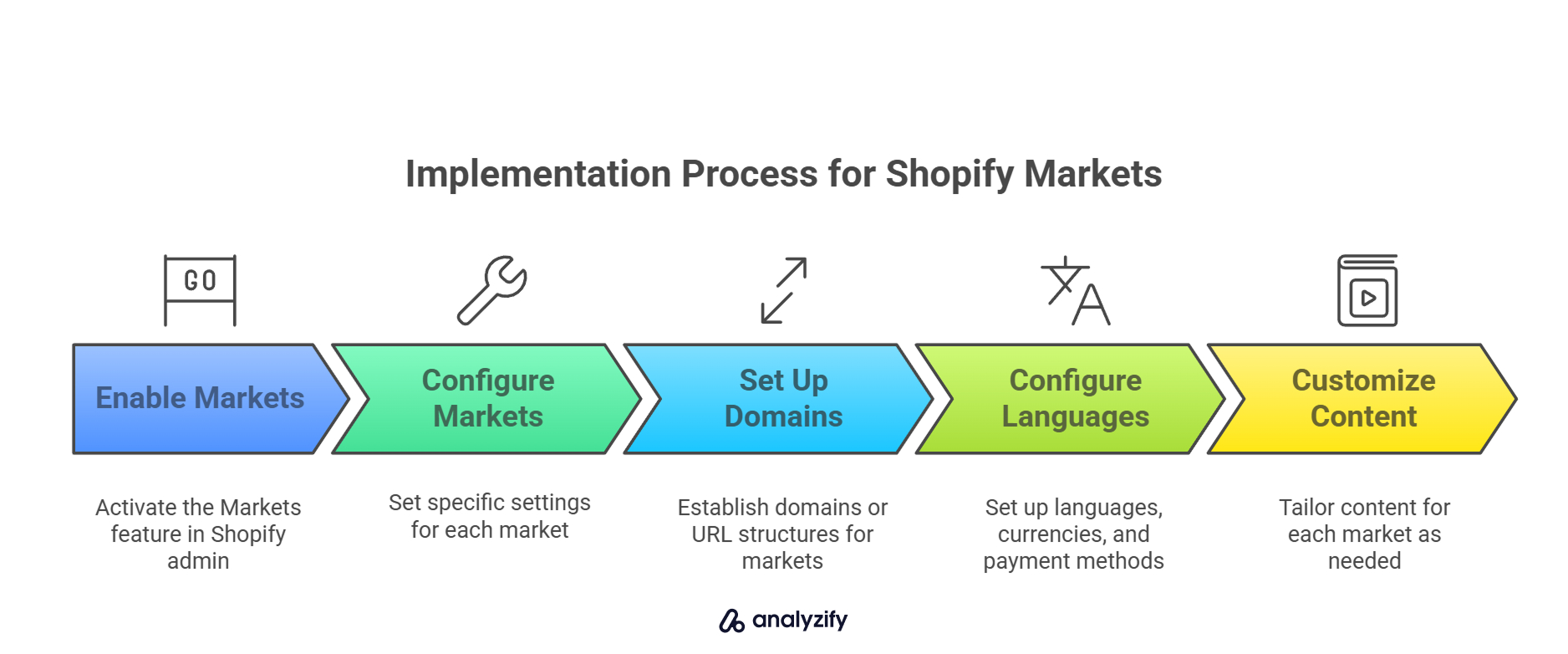
The technical simplicity is a major advantage compared to managing multiple stores. Shopify handles critical technical elements automatically, such as setting up proper hreflang tags for SEO, configuring redirects based on customer location, and implementing proper URL structures for international SEO.
However, this simplicity comes with less flexibility for advanced customizations compared to separate stores.
Shopify Expansion Stores: Benefits, Limitations, and Costs
If you need more control and independence for your international operations, Expansion Stores provide an alternative approach to Shopify Markets. Let’s explore what this option offers.
Complete Feature Analysis of Expansion Stores
Expansion Stores are completely separate Shopify storefronts that operate independently of your main store. Each store functions as its own entity with a dedicated admin panel, settings, and configurations.
The key advantages of this approach center around the independence and flexibility it provides:
1) Independent business operations
Each regional store functions as a standalone business with its own catalog, pricing strategy, and content. Decisions made for one market have no technical or operational impact on your other markets, allowing for truly tailored experiences in each region.
2) Complete localization and customization
Expansion stores allow you to adapt the entire customer experience to local preferences:
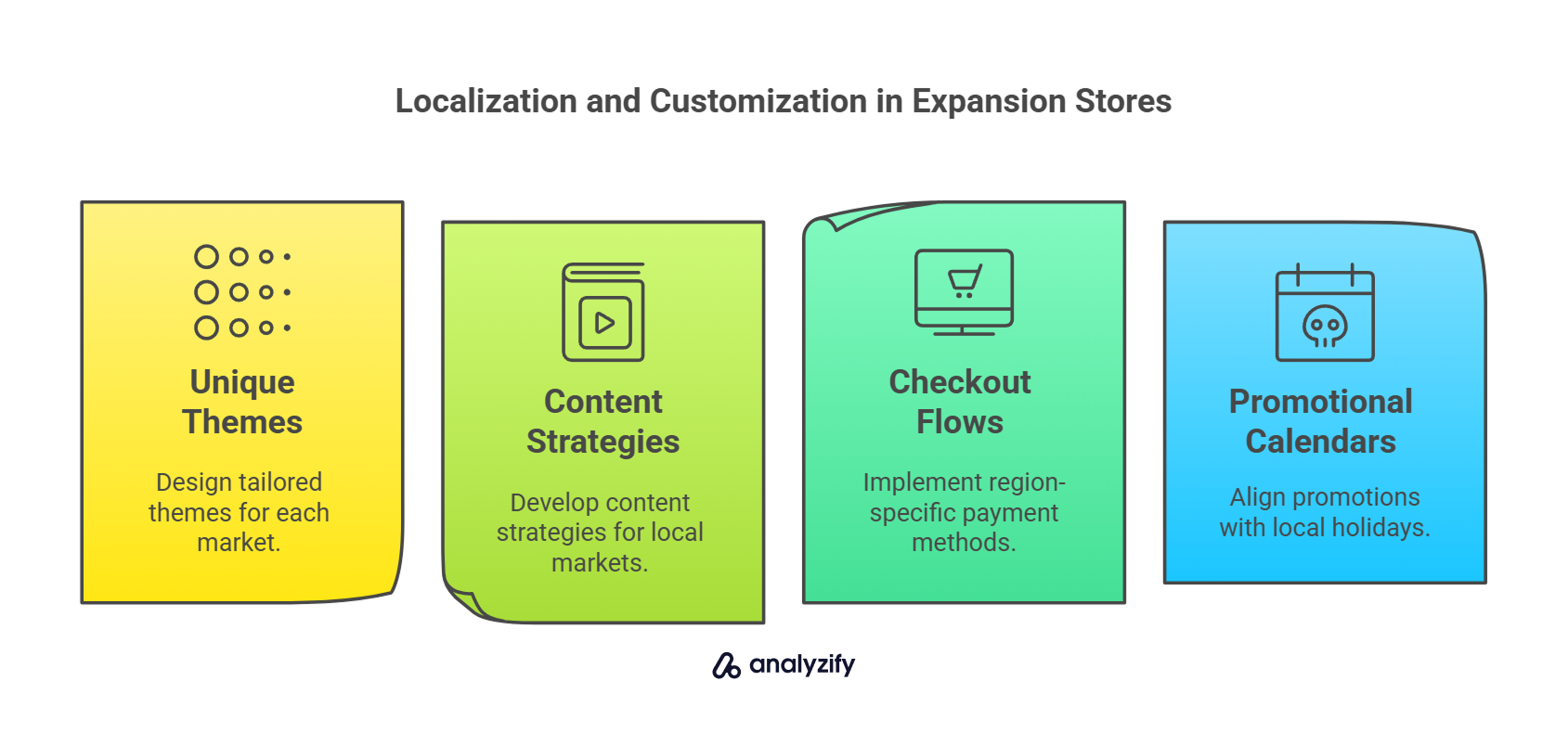
- Design unique themes and layouts for each market
- Create market-specific content strategies and product catalogs
- Implement region-specific checkout flows with local payment methods
- Run independent promotional calendars aligned with local holidays and seasons
3) Regionalized team management
Different team members or teams can manage regional stores simultaneously without creating conflicts or bottlenecks. This structure works particularly well when different languages or business practices are involved, as teams can work in parallel on their respective stores.
Total Cost Considerations Beyond Subscription Fees
Important: While the independence benefits of expansion stores are valuable, they come with significant cost implications:
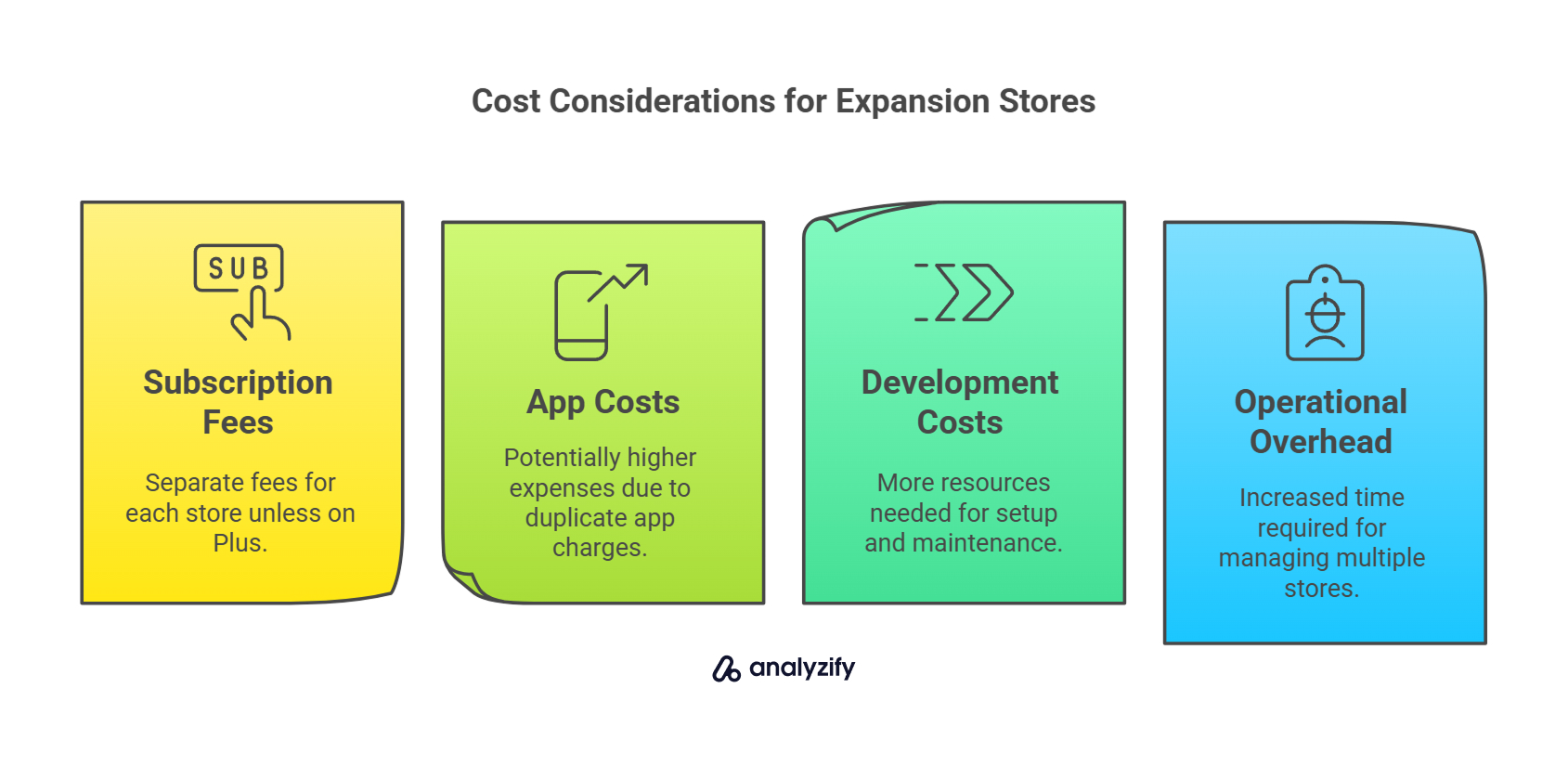
- Multiple Shopify subscriptions: Unless you’re on Shopify Plus (which includes 9 expansion stores), you’ll pay separate subscription fees for each store.
- Duplicate app costs: Many app developers charge per store, potentially multiplying your tech stack expenses.
- Higher development costs: Initial setup and maintenance across multiple stores requires more development resources.
- Increased operational overhead: Managing multiple admin panels and configurations demands more time from your team.
For Shopify Plus merchants, the ability to have up to 10 stores total under one subscription represents significant savings. If you’re not on Plus, carefully weigh whether the benefits justify the additional subscription costs.
One financial advantage: you avoid the 2% currency conversion fee that Shopify Markets charges. For high-volume sellers, this savings might offset the higher operational costs.
Independent Management Structure Requirements
Operating multiple stores effectively requires careful consideration of your team structure:
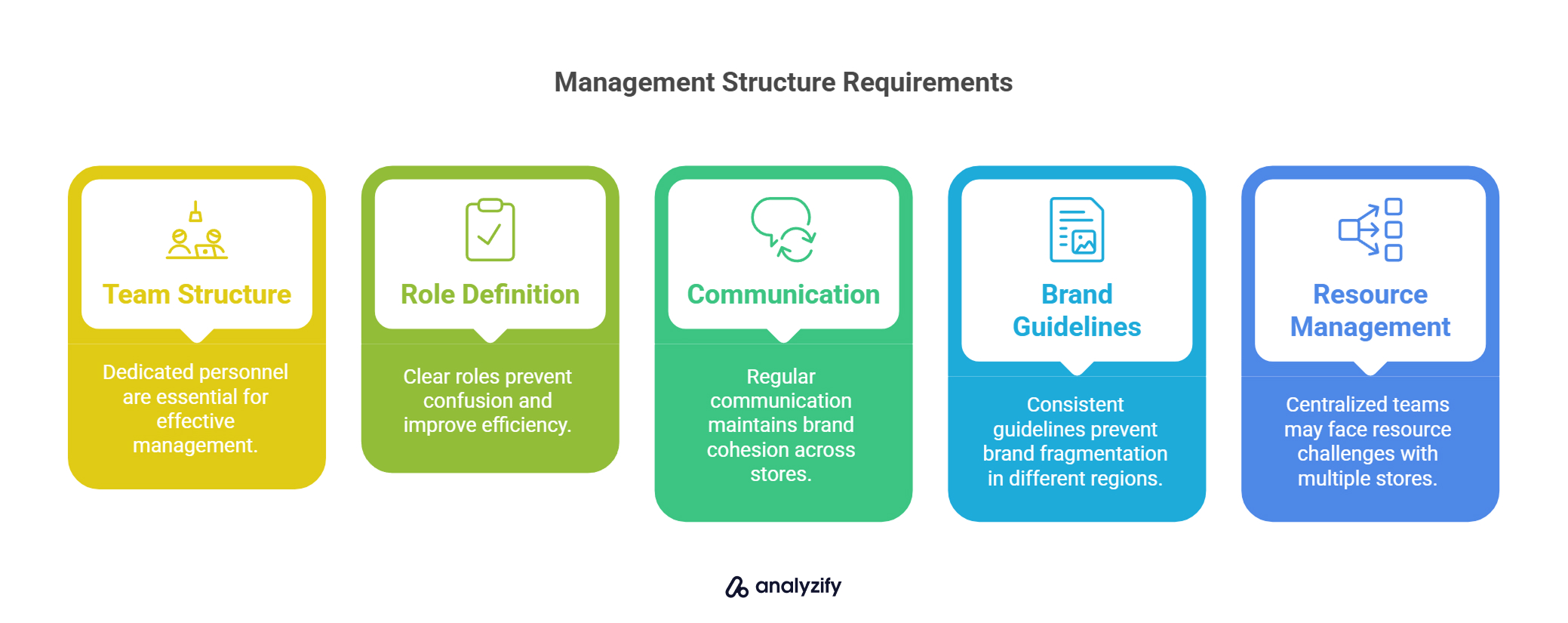
Each store may need dedicated personnel for management, content creation, and customer service—especially if different languages are involved. Consider your current team’s capacity and skills to manage multiple storefronts effectively.
Well-defined roles and processes become critical when operating across multiple platforms. Clear responsibilities prevent confusion and operational inefficiencies.
Regular cross-team communication ensures your brand remains cohesive despite store independence. Consistent brand guidelines and cross-market learnings require intentional coordination to prevent fragmentation of your brand experience across regions.
Note: For businesses with region-specific teams already in place, expansion stores align naturally with your organizational structure. If you have a centralized team, managing multiple stores might stretch your resources thin.
Technical Implementation Requirements
Setting up expansion stores involves more complex technical considerations:
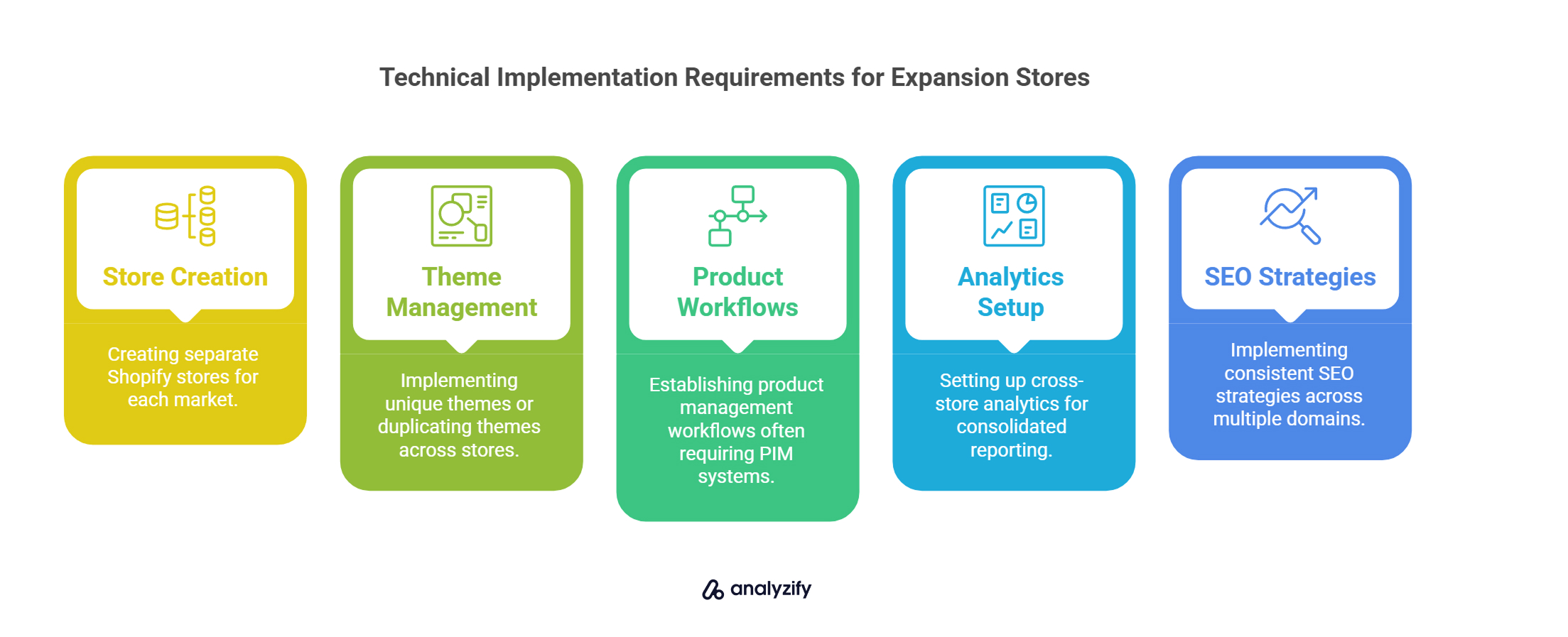
-
- Creating separate Shopify stores for each market
- Implementing unique themes or duplicating themes across stores
- Establishing product management workflows (often requiring PIM systems)
- Setting up cross-store analytics for consolidated reporting
- Implementing consistent SEO strategies across multiple domains
Synchronizing product data, inventory, and content across multiple stores typically requires additional tools or custom development. Many merchants implement Product Information Management (PIM) systems to maintain consistency.
For technical SEO, expansion stores use completely separate domains (e.g., yourstore.com, yourstore.de). This creates clean separation but requires additional work to establish domain authority for each site individually.
The technical complexity increases with each additional store, making this approach better suited for businesses with dedicated technical resources or agency partners.
Bonus: Here our hand-picked list of Top 10 Shopify Plus Agencies for Ecommerce!
Choosing Between Shopify Markets and Expansion Stores: 6 Critical Factors
After understanding what each option offers, you need a practical framework to make your decision. Here are the eight most important factors to consider when choosing between Shopify Markets and Expansion Stores:
Currency Management and Payment Processing Requirements
Your currency needs will heavily influence your decision:
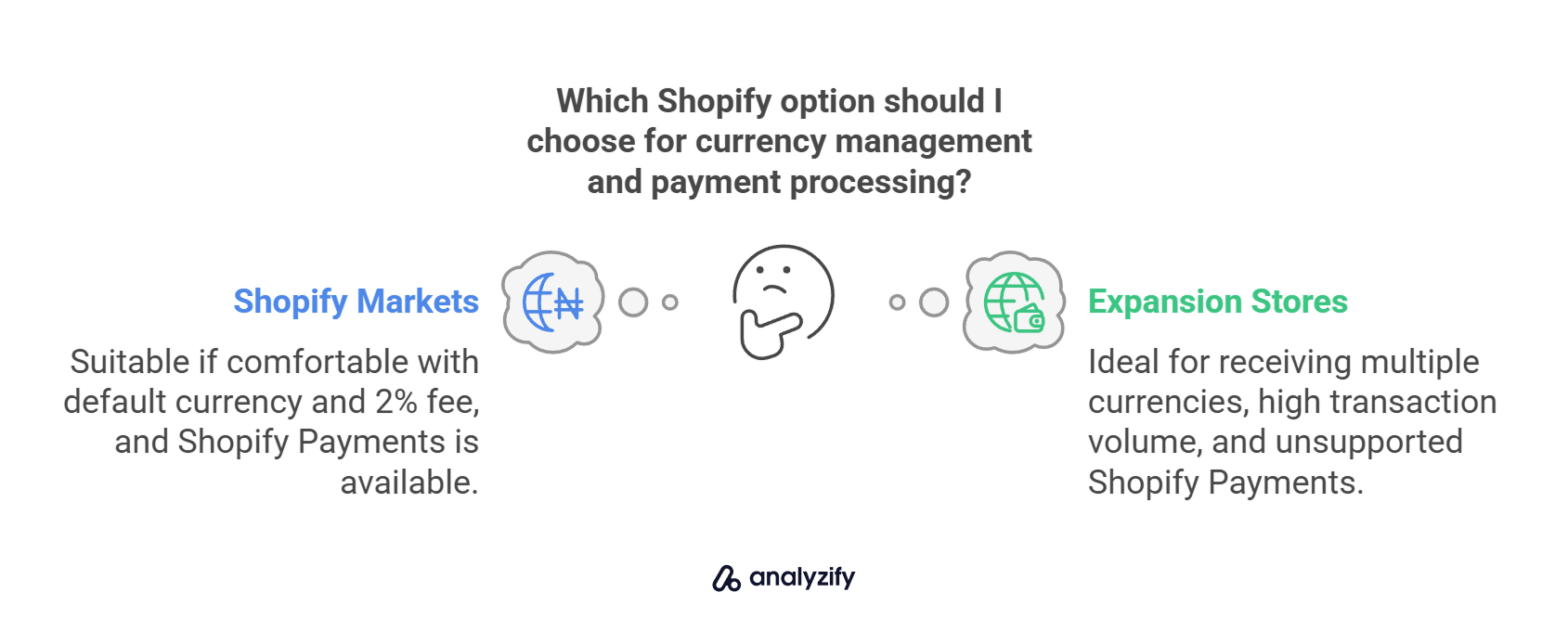
Choose Shopify Markets if:
- You’re comfortable receiving all payments in your store’s default currency
- The 2% currency conversion fee is acceptable for your profit margins
- You operate in regions where Shopify Payments is available
Choose Expansion Stores if:
- You need to receive payments in multiple currencies directly
- Transaction volume is high enough that the 2% fee would significantly impact profits
- You operate in regions where Shopify Payments isn’t supported
Example scenario: Let’s say you run a clothing brand based in the US. If you’re primarily selling domestically with only 10-15% of sales coming from international customers, Shopify Markets would likely be cost-effective. However, if international sales grow to represent 40% of your business, the 2% conversion fees would start to significantly impact your bottom line, making expansion stores more economical.
Team Structure and Regional Management Needs
Your organizational structure should match your technical approach:
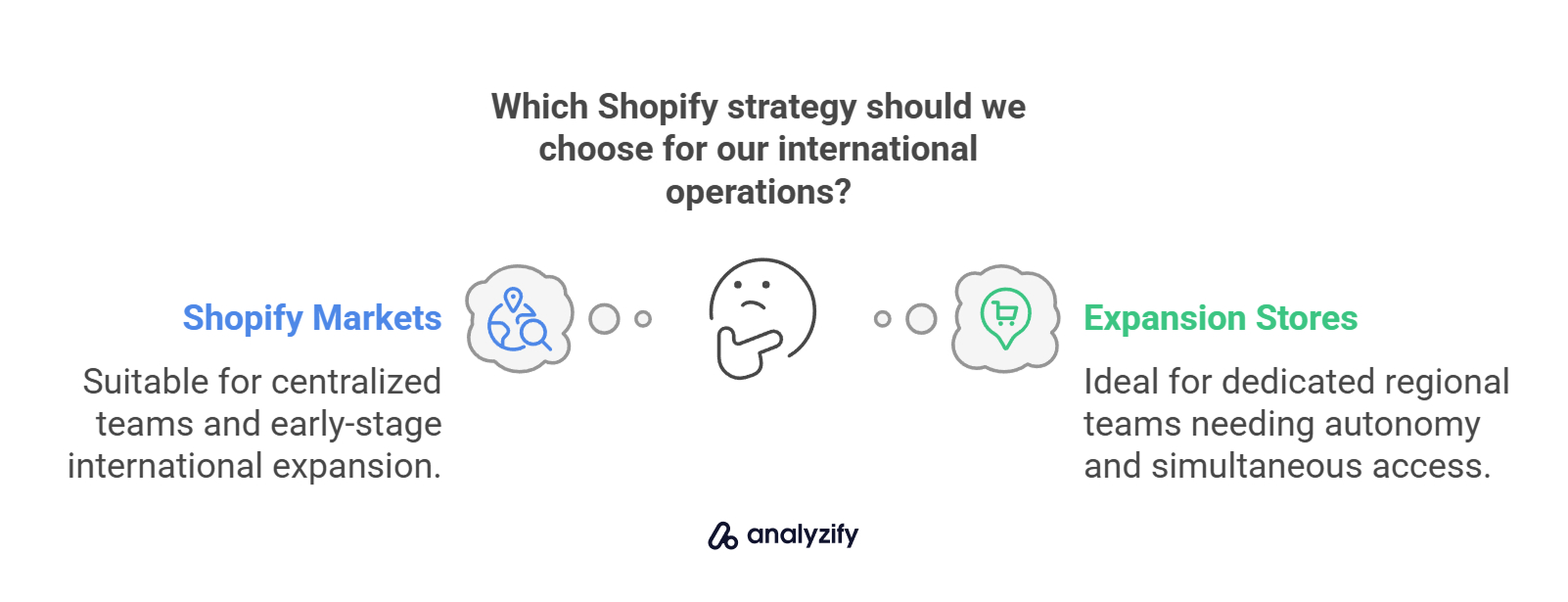
Choose Shopify Markets if:
- You have a centralized team managing all markets
- Your international operations are handled by the same people
- You’re in early stages of international expansion with limited regional staff
Choose Expansion Stores if:
- You have dedicated teams for different regions
- Regional managers need autonomy over their stores
- Different team members need simultaneous access to update different stores
Example scenario: If your clothing brand has a small marketing team handling all regions from your US headquarters, Shopify Markets would streamline operations. If you later hire dedicated marketing managers in Europe and Asia who need to update content independently and simultaneously, expansion stores would provide the necessary autonomy.
Content Differentiation Between Markets
Consider how different your content needs to be across markets:
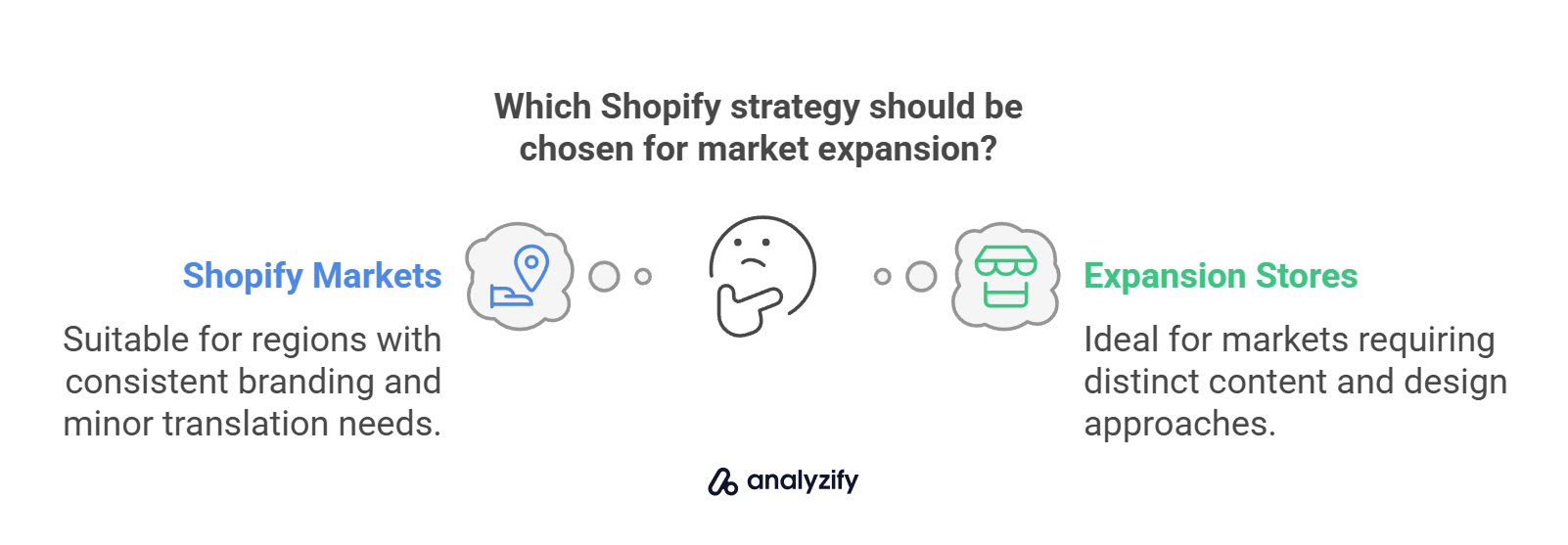
Choose Shopify Markets if:
- Your branding and content are largely consistent across regions
- Translations with minor regional adjustments are sufficient
- You can manage with shared product images and media across markets
Choose Expansion Stores if:
- Markets require fundamentally different content approaches
- Product presentation needs vary significantly by region
- You need completely different layouts and designs for different markets
Example scenario: If your clothing brand’s marketing approach works globally with simple translations and minor seasonal adjustments, Shopify Markets would be sufficient. However, if you need completely different visual merchandising in Japan (showing outfits styled differently) versus the US, expansion stores would give you the necessary flexibility.
Legal Entity and Tax Requirements
Legal and tax considerations are often overlooked but critically important:
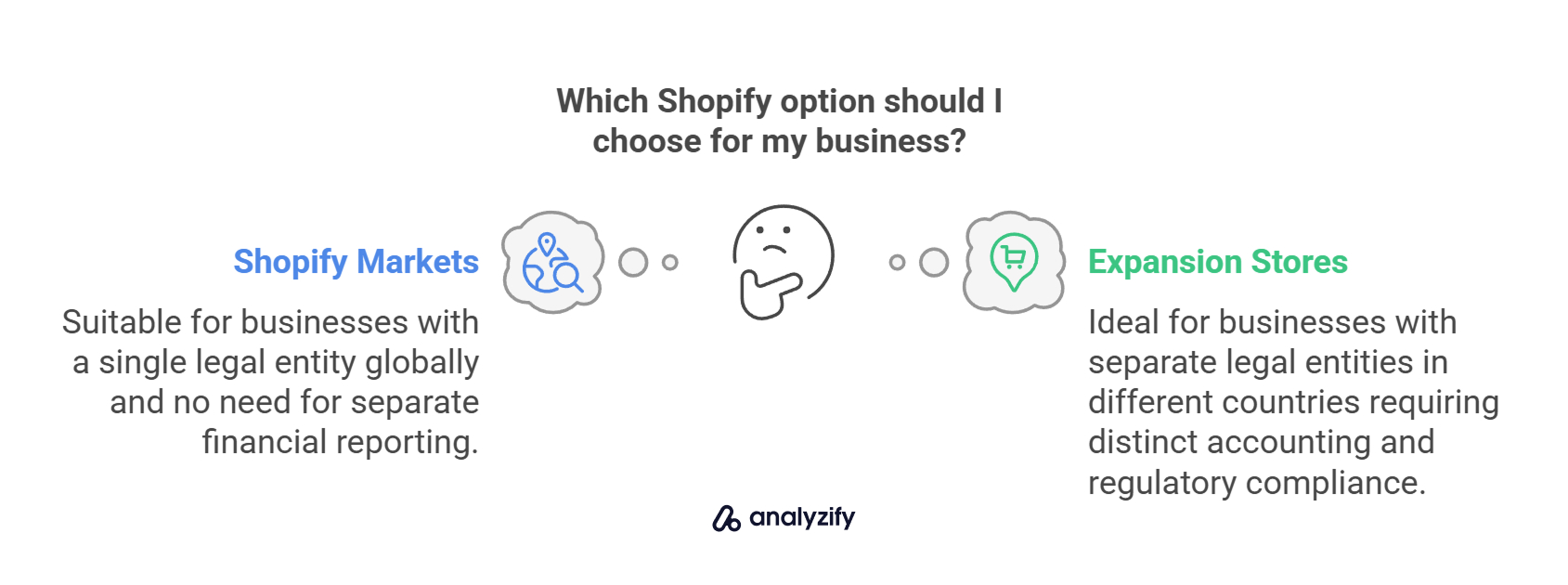
Choose Shopify Markets if:
- You operate as a single legal entity globally
- Markets Pro handles your tax compliance needs effectively
- You don’t need separate financial reporting by region
Choose Expansion Stores if:
- You have separate legal entities in different countries
- You need separate accounting and tax reporting by market
- Different regulatory requirements demand separated operations
Example scenario: If your clothing brand creates a separate legal entity in the EU to simplify VAT compliance, you might need expansion stores to properly separate financial reporting and tax obligations. This allows clean financial boundaries between your US and EU operations.
Technical SEO and Domain Strategy
Your approach to domains and SEO impacts your decision:
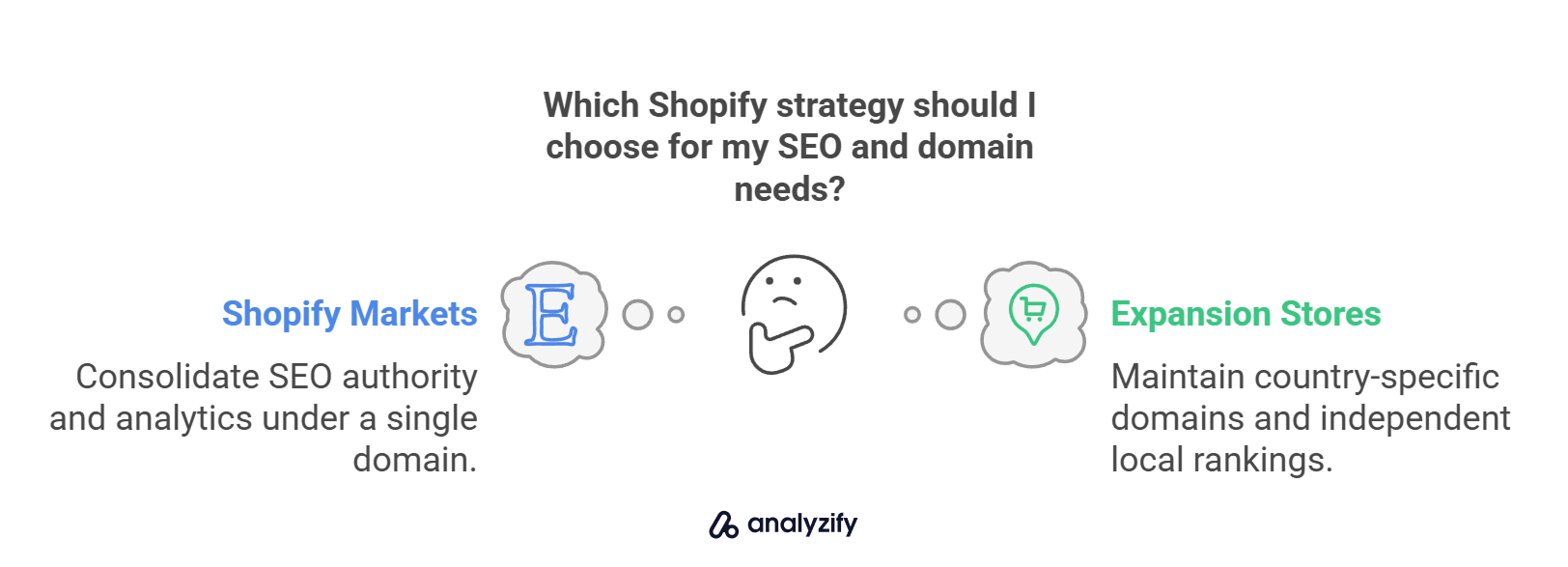
Choose Shopify Markets if:
- You want to consolidate SEO authority under a single domain
- Subfolder structure (yourbrand.com/uk/) works for your SEO strategy
- You prefer unified analytics across all markets
Choose Expansion Stores if:
- Country-specific domains are important for your markets
- You want to rank independently in local search results
- Regional SEO strategies require completely separate management
Example scenario: If your clothing brand has built significant domain authority for yourclothingbrand.com, using Shopify Markets with subfolders (yourclothingbrand.com/fr/) might leverage that existing SEO strength. If you need completely different SEO strategies with locally-focused keywords in each market, separate domains through expansion stores might be more effective.
Pricing Model and Transaction Fee Impact
Financial implications vary based on your business volume:
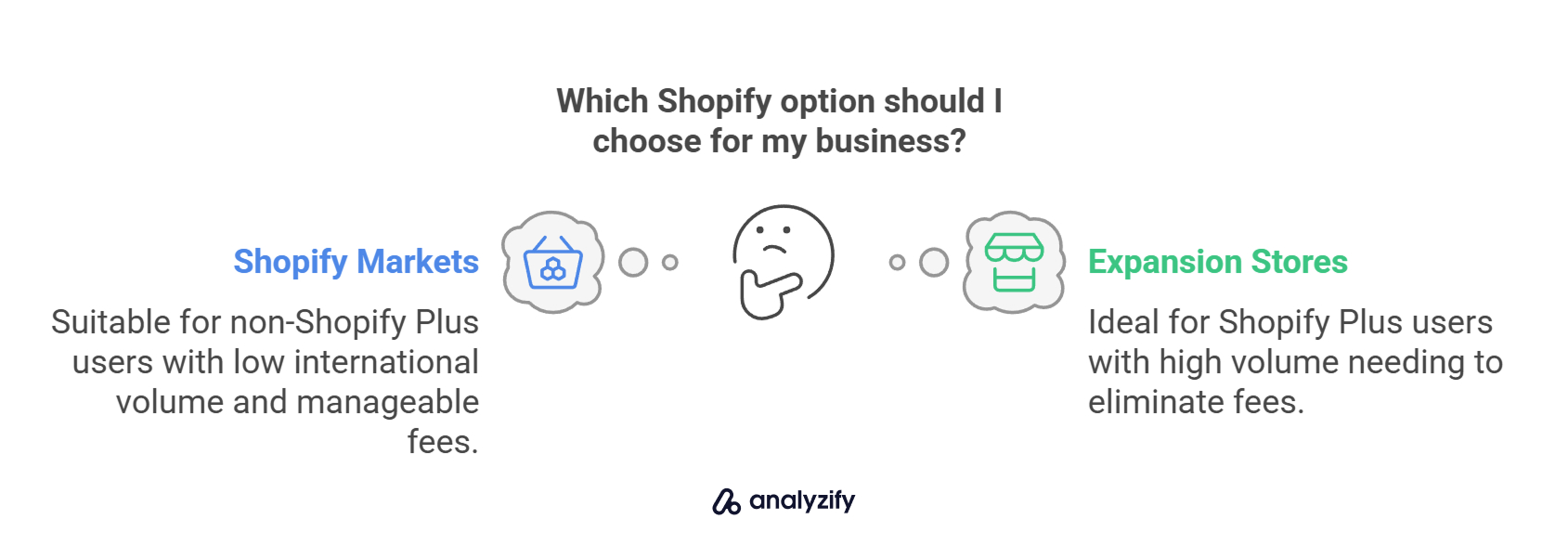
Choose Shopify Markets if:
- You’re not on Shopify Plus and additional subscription fees would be costly
- Your international transaction volume is relatively low
- The Markets 2% fee has less impact than multiple subscriptions
Choose Expansion Stores if:
- You’re on Shopify Plus with 9 expansion stores included
- Your transaction volume makes the 2% fee more expensive than separate stores
- You need to avoid all transaction fees in specific high-volume markets
Example scenario: If your clothing brand operates on Shopify Plus with $3 million annual revenue and 30% ($900,000) from international sales, you’d pay approximately $18,000 in currency conversion fees with Markets. Since Shopify Plus includes additional stores, expansion stores would eliminate these fees, making them financially advantageous.
Bonus: Learn more about Shopify Fulfillment Network: Costs, Features, and Alternatives!
Conclusion: Shopify Markets vs. Expansion Stores — Final Takeaways
Choosing between Shopify Markets vs. Expansion Stores isn’t just about features—it’s about how your business operates today and where it’s headed.
If you’re early in your international journey, Shopify Markets gives you an efficient way to expand without multiplying your workload. You can localize languages, currencies, and content from one admin panel.
But keep in mind the 2% currency conversion fee, limited payout options, and shared control structure. These become more limiting as your international sales volume or regional complexity increases.
Expansion Stores, on the other hand, give you full control: separate domains, tailored marketing, independent teams, and region-specific setups. That also means higher costs, more apps to manage, and a greater operational burden.
But if you have different legal entities, need local payouts, or manage distinct strategies by region, the control is worth it.
Most businesses don’t get this choice perfect on day one. It’s common to start with Shopify Markets and later shift to Expansion Stores as you scale. Look at your team capacity, cost tolerance, and how different your markets really are. That will tell you which path makes the most sense right now.
FAQ: Shopify Markets vs. Expansion Stores
Here are the frequently asked questions on Shopify Markets vs. Expansion Stores, based on what users typically search on Google:
What’s the main difference between Shopify Markets and Expansion Stores?
Shopify Markets lets you manage multiple regions from a single Shopify store. You can localize content, pricing, and domains while keeping everything under one admin. Expansion Stores, by contrast, are entirely separate Shopify stores for each market. This gives you full independence in design, checkout, content, and management—ideal if regions need distinct approaches or separate teams.
Can I receive payouts in multiple currencies using Shopify Markets?
No. Shopify Markets only pays out in your store’s default currency. If you sell in EUR and USD but your store currency is USD, all payouts are in USD. If you need to receive funds in local currencies (for example, payouts in EUR for a European store), you’ll need to use Expansion Stores instead.
Is it better to use Expansion Stores for SEO?
Yes, in some cases. Expansion Stores allow you to use country-specific domains like yourstore.fr or yourstore.de, which can help with local search rankings. They also let you build completely separate SEO strategies per region. Shopify Markets uses subfolders (like yourstore.com/fr), which consolidates SEO authority but offers less flexibility for targeting local keywords and content.
How much does Shopify charge for currency conversion in Shopify Markets?
Shopify charges a 2% fee on any foreign currency transaction unless you’re using Shopify Payments in a supported region. This fee applies on top of your regular transaction costs. For high-volume international sales, that 2% can add up fast—sometimes making Expansion Stores more cost-effective in the long run.
When should I switch from Shopify Markets to Expansion Stores?
Switch when your international operations start needing more autonomy. This could be when teams in different regions need to manage their own content, when your products or branding vary heavily by country, or when transaction volume makes Shopify Markets’ currency fees too costly. Expansion Stores also make more sense when you’re dealing with separate legal entities or complex tax/reporting needs per region.

































